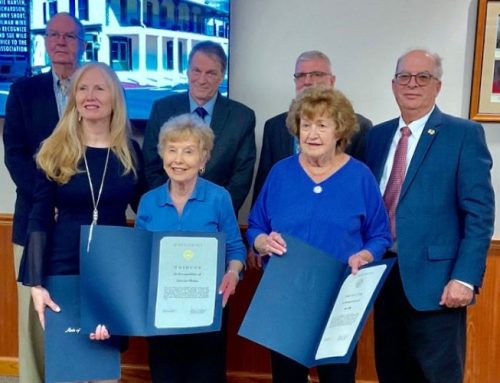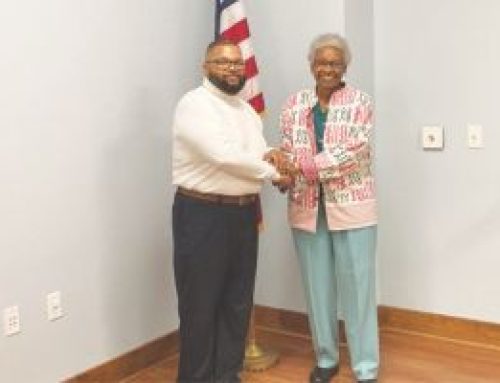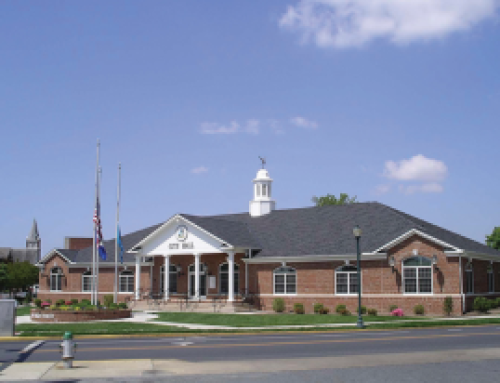It wasn’t easy deciding what to call the medical organization formed by the recent merger of Nanticoke Health Services, Seaford, and the Peninsula Regional Medical Center in Salisbury. But TidalHealth, announced last week as the health services company’s new name, “just seems to fit,” said president and CEO Steve Leonard.
The Nanticoke, indigenous people for whom the river that flows by Seaford was named, “were tidal people,” he said. And a peninsula “is formed from the rising and lowering of tides.”
Leonard and Penny Short, president of what is now called TidalHealth Nanticoke, were at the Seaford City Council meeting Tuesday night, to talk about what the merger of Nanticoke, founded in 1950, and Peninsula, which dates back to 1897, means to the community. Primarily, it will mean “enhanced services in Seaford,” particularly in the areas of cardiology and cancer treatment, Short said.
Seaford’s Allen Cancer Center is now a part of the Richard A. Henson Cancer Institute in Salisbury, which means that patients there can participate in research and clinical trials. The Henson Institute is also affiliated with several national collaborations, including research at Johns Hopkins School of Medicine in Baltimore. Those connections “will bring a whole new level of service to Seaford,” Short said.
In cardiology, electrophysiology studies are now available in Seaford, performed by doctors who travel to Nanticoke from Salisbury.
The merger meant an infusion of cash, “to make sure we have state-of-the-art equipment and facilities,” Short said. It also meant that the Seaford area has access to Peninsula’s Wagner Wellness Van, which can take basic healthcare to outlying places. “Currently, we are working out a plan to get flu shots out to underserved communities,” Short said.
The new TidalHealth has 50 locations, including the two hospitals. More than 5,000 people work for the organization, which has $1 billion in assets.
TidalHealth Medical Practice has 250 employed doctors working in 22 specialties. “We expect that number to be up to 280 or even 300 in the next few years,” Leonard said.
TidalHealth’s number one goal is to “connect people with primary care physicians,” Leonard said. “People who have primary care physicians have healthier lives.”
Secondly, for people who need some type of medical treatment or service, “we’re going to compete to provide it,” he said. “If you’re a member of our community, we want to see you engaging with us.”
At the conclusion of the presentation by Short and Leonard, Mayor David Genshaw said that the city is excited about the promise of growth at TidalHealth Nanticoke. “Our focus is on growing our economy, and the hospital is a key part of our sales pitch to developers and business owners,” he said. “It is an incredible asset to the community and we are looking forward to where this new path will go.”
With bid awarded, work can begin at Oyster House Park
The winning bid to complete Phase 1 of development of Seaford’s new Oyster House Park came in at $300,000 less than the architect’s estimate.
The Dissen & Juhn bid for $998,000 was the lowest of four bids on the project. Even with the addition of $100,000 for contingencies and administration of the work, the bid from the Stevensville, Md., company was lower than the estimated $1.3 million.
The Seaford City Council Tuesday night followed the recommendation from Landscape Architectural Services and accepted the bid. Landscape Architectural, Dover, was hired by the city last year to draw up plans for the new park.
The city has a little more than $1.2 million in funding to complete Phase 1, said Trisha Newcomer, the city’s director of economic development and community relations. When this phase is completed, “we will have some money left over to move into the next phase,” she said.
Oyster House Park is slated for nearly an acre of land along the Nanticoke River, stretching from South Pearl Street east past Church Street. Phase 1 will include an extension of the city’s Riverwalk, new bulkhead and construction of a pier, gangway and floating docks.
The property was purchased in 2018 by the Chesapeake Conservancy and given to the city. The conservancy paid $244,000 for the land, using funding from the Mt. Cuba Center near Wilmington.
Since then, the conservancy has worked to find funding for the park. Funding for Phase 1 includes $250,000 from the Longwood Foundation, $100,000 from the Crystal Trust and the Welfare Foundation and $400,000 from the state’s Community Transportation Fund.
The property is the former site of the J.B. Robinson Oyster House, where oysters harvested from the Chesapeake Bay and its tributaries were brought in and then sorted for shipment to regional cities. The park will have interpretive panels, explaining the history of Seaford and the role that the town played in the oyster industry, as well as in shipbuilding. A planned visitor’s center would be a small (about 2,000-square foot) replica of the oyster house.
The park will serve as an access point for the National Park Service’s Captain John Smith Chesapeake National Historic Trail.
In February, the city council approved a master plan for the park.
City council approves revised special events ordinance
After tabling it at an August meeting following a second reading, the Seaford City Council Tuesday night approved a revised ordinance regarding permits for special events.
The vote to approve the ordinance was 3 to 1, with Councilman Jose Santos the lone outlier. (Councilman James King was absent from the meeting.) As he did during the Aug. 25 meeting, Santos argued that the $100 permit application fee should be refundable. “For a lot of people, $100 is a lot of money,” he said.
Councilman Dan Henderson countered that the $100 is meant to reimburse the city for time and effort put in by staff to respond to the application for a permit. “If you go through the entire process with all the departments, $100 doesn’t event touch the costs involved in planning a special event,” he said.
Santos also objected to the use of the word “servant” in describing who can apply for the permit. The person who makes the application can be “any natural person, firm, association, joint venture, joint stock company, partnership, organization, club, company, corporation, business trust or manager, lessee, agent, servant, officer or employee of any of them,” the ordinance reads.
Santos’ motion to accept the ordinance with changes — making the application fee refundable and removing the word “servant” — failed for the lack of a second. Henderson made the subsequent, and successful, motion, to approve the ordinance as written.
At its first reading Aug. 11, city solicitor Daniel Griffith told councilmen that he wrote the revised ordinance in light of the recent “tension between the public right to use public property for protest and the government’s right to protect the property.”
“This is a very proactive agreement,” Griffith continued. “It sets forth under what conditions a special permit is needed, and balances the public’s right to use public property versus the government’s right to restrict that use.”
He predicted that, under the ordinance, there would be “very limited circumstances” under which a special permit is required. In general, “if you require city services, such as police for traffic control, you will need a permit. If you’re going to use public space for an extended period of time, so that other members of the public can’t use it, you will need a permit.”
Exemptions to the requirement to get a permit include funeral and wedding processions; school, church and government events; protests or other expressive activities on sidewalks; events at facilities designed to hold such things; regularly scheduled athletic events; and outdoor demonstrations on public property.
Comprehensive plan update delayed by pandemic
The ongoing coronavirus pandemic has delayed work on the city of Seaford’s comprehensive plan. The city’s current plan, which under state law has to be updated every 10 years, expired in January.
During Tuesday night’s city council meeting, a representative with KCI, the firm that the city hired in 2018 to update the plan, said that work is progressing. Planning administrator Debbie Pfeil said that even under a worst-case scenario, she anticipates that the plan will be completed and ready for certification from the governor by March.
Pfeil presented councilmen with a draft of the plan. Chapters include Economic Development, Historic and Cultural Resources, Open Spaces and Recreation, Transportation, Environmental Protection, Infrastructure and Land Use.
The next step is to review the draft plan with city staff, Pfeil said. Toward the end of November, she expects that the draft will be presented at a public meeting. Comments about the plan will be accepted until early January.
The draft will be updated based on those comments, and will come back before the council for final approval.
Development of the comprehensive plan included a public phase, during which residents, business owners, even visitors, were asked what it is that they like about the city and what concerns them.
Surveys were available on the city’s website and at city hall. On Tuesday, Pfeil said that the city held “multiple outreach events” to allow people to voice opinions about the plan.
That involvement of the public extends to the actual plan itself, she added. She hopes to make it more user-friendly, so that someone who is interested in housing or transportation, for example, can turn to the appropriate chapter and find all pertinent information. In addition, the draft includes a chapter about city departments, boards and commissions, explaining what each does and providing contact information.





